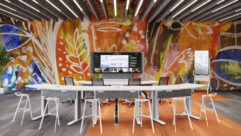
AV Brings Virtual Fish Tanks To Life
AMONG ALL of the unusual requests Larry Schirmer of Farmington Hills, MI-based Illuminating Concepts has run across in his life, one clearly stands out. ?I’ve done some different things over the course of my career, but up until recently, I’ve never had a client ask me to create a pair of virtual, high-definition AV fish tanks,? says the designer of AV, multimedia, lighting, and FX systems.
CHALLENGE: Create a pair of lifelike AV fish tanks in an aquatic-themed lounge at a Las Vegas hotel and casino.
SOLUTION: Install compact, broadcast-quality video processing and multi-projector media to create a realistic, virtual aquarium that offers bar patrons picture-in-picture cable feeds.
A pair of compact Christie Digital RoadRunner LX100 LCD projectors mounted within the Seahorse Lounge ceiling can be lowereed into position and turned on while the bar is open for business. The projectors receive encoded HD fish signals from a Visual Circuits Mantis 1080i video playback unit, as well as a standard cable feed offering a variety of sports channels.
AMONG ALL of the unusual requests Larry Schirmer of Farmington Hills, MI-based Illuminating Concepts has run across in his life, one clearly stands out. “I’ve done some different things over the course of my career, but up until recently, I’ve never had a client ask me to create a pair of virtual, high-definition AV fish tanks,” says the designer of AV, multimedia, lighting, and FX systems.
The client request in this case came from Caesars Palace Las Vegas. “Frequently we get involved in projects anywhere from 12 to 18 months in advance,” Schirmer says. “Sometimes we even come in before anyone else, as many of our clients count on us to help determine what kind of architect or general contractor they should hire. But at Caesars this time, things were different. A clear-cut vision was brought to us, and we had to meet the challenge of how to turn that idea into reality.”
Having utilized Illuminating Concepts’ consulting services before, Caesars didn’t hesitate to call upon the group again when it came time to develop its newest upscale bar, the Seahorse Lounge. As main focal points located behind the bar itself, the virtual fish tanks envisioned for the room took shape within oval windows bordered by filigreed frames. Seeking lifelike, high-definition quality for its virtual sea creatures, as well as an ability to superimpose picture-in-picture (PIP) cable feeds over the swimming fish to display sporting events, Caesars left all of the technical details required to Schirmer and the Illuminating Concepts team.
Starting at square one, Schirmer began searching for a practical way to supply the project with the required visual content. Ultimately having to travel no further than the atrium in Caesars’ own Forum Shops, where a large saltwater fish tank occupies a sizable expanse of one wall, a local camera crew known for capturing the majesty of the nearby Grand Canyon was hired to record a full 60 minutes’ worth of high-definition, real-world fish images on tape.
“Explained in very simple terms, the process of getting the fish on tape essentially replicates what you’d see if you simply placed an HD camera on a tripod in front of the tank, and then let it run for an hour,” Schirmer says. “The resulting images were colorful, fluid, and amazingly realistic. It was exactly what we needed.”
CHROMAKEY 101
Used in the Seahorse Lounge at Caesars Palace Las Vegas to help manage its virtual aquariums and PIP functions, chromakeying is a versatile video processing tool that has been available for decades. To understand how it works, consider that when a scene is photographed by a color camera, the reflected light from objects in the scene is broken up into millions of electrical samples. Each sample contains two components: a luminance component that represents the brightness of a microscopic point within the picture, and a chrominance component that represents the color information for that same point.
When these samples are sent to a monitor, the process is reversed and you see a recreation of the photographed image in color. Sample the scene 30 times a second and you can replicate motion.
Deceptively simple in concept, chromakeying merely requires placing a person or object in front of a uniformly illuminated wall — usually blue or green in color — and then inserting electronics into the signal path to remove or “key” out that portion of the image containing the target color. In its place a new background is inserted.
The devil is in the details, though, and early on, broadcast engineers using the technique discovered that the background had to be uniformly lit or the circuits would be fooled. Similarly, if the talent got too close to the wall and cast a shadow, the circuitry would be tricked. In both cases, the illusion was destroyed.
The problem was the chromakey circuitry only worked properly when the chrominance/luminance combination was one and only one value. Deviate from this path, and the keying process would quickly produce video smearing and tearing.
The initial solution was to widen the range of acceptable values for the target color, but on occasion this introduced new problems. Sometimes the wardrobe used by the talent could be confused with the background color, and a portion of the talent would be keyed out and filled with the new background.
Eventually a technique called scene accommodation was invented, wherein the user of the chromakey device was provided with adjustments that allowed the range of acceptable key values to be adjusted as required for a particular scene. Today the use of this technique produces crisp chromakeys not subject to the early problems of smearing and tearing, and as a result, magical things are becoming more commonplace.
— John Loughmiller, TV One
In keeping with the client’s desire to have all of the AV system components remain as unobtrusive within the environment as possible, a pair of compact Christie Digital RoadRunner LX100 LCD projectors — which were mounted within the Seahorse Lounge ceiling — can be lowered into position and turned on while the bar is open for business. Aimed so that there’s never an opportunity for anyone standing or seated within the viewing area to block the images in either of the two oval-shaped windows, the projectors, which use RPA Series mounts from Chief Manufacturing, receive encoded HD fish signals from a Visual Circuits Mantis 1080i video playback unit, as well as a standard cable feed offering a variety of sports channels.
Projected to their respective spots behind the bar within the oval-shaped window frames (which measure 4 feet across at their widest points and stand 9 feet high), the aquatic images swim freely directly upon the bar’s wall surfaces, which are coated with Screen Goo — a specially formatted, highly-reflective paint from Goo Systems. To provide the projected light with a clean edge to play against, a 1-inch black border was painted all the way around the white Screen Goo finish inside each of the ovals.
With the basics in place for projection and screen content, Schirmer turned his attention to the system’s PIP functions. “The goal in this case was to enable the fish to remain swimming in the background while a 4- by 3-foot cable sports feed was dropped on top of each virtual aquarium into the center of the window,” Schirmer explains. “We had no idea of how we were going to make that happen at anything less than a great expense, until we found out about TV One’s C2-5100 multi-format video processor.”
The C2-5100 from TV One is a 1 RU video scaler, up/down converter, and seamless switcher that also performs PIP duties and serves as a chromakeyer, lumakeyer, frame synchronizer, time base corrector, aspect ratio converter, and more. Using a pair of C2-5100 processors, Schirmer utilized the devices’ chromakey and PIP capabilities to enhance and superimpose the secondary 4- by 3-foot sports channel cable feeds seen within each oval screen.
“With the TV One units, we were able to program a switchable setting where a 4- by 3-foot black area was created on top of the fish tank images via chromakeying, and then the sports feed was programmed to play on top of it,” he says (see sidebar on page 40). “We used the same technique to process the main fish tank images. In this instance, because the fish were designed to be projected upon a white surface bordered by black, we simply programmed the TV One units to play the high-definition fish video only on the white area. The black border effectively ‘stopped’ the fish from playing beyond that point, and gave the swimming images their oval shape.”
From the outset of the project, Schirmer recognized that system control would require little more than providing a method for turning on and off the projectors and PIP feature. Meeting these needs nicely with existing AMX hardware and software already in use onsite, he used a pair of unused dry closures to serve his purposes.
With high-definition cable running over distances of 300 feet from the equipment rack housing the TV One C2-5100 processors to the projectors, Schirmer also called upon an Extron VTT-001 Cat5-to-RGBHV transmitter and VTR-001 RGBHV-to-Cat5 receiver to help maintain signal quality. “It wasn’t that long of a distance, but still one requiring that we take action to ensure picture integrity,” he says. “From one end of the project to the other, every effort was made to maintain quality. We even built a system mock-up in our own facility prior to the installation to make sure that everything would work perfectly onsite. Testing was definitely essential to the process of calibrating the projectors, as we knew early on that we would have to exceed the standard keystone settings in order to make them do what we wanted. We wound up taking them all the way to the edge, and then used the TV One processors to supply a little extra.”
FOR MORE INFORMATION
- Chief Manufacturingwww.chiefmfg.com
- Christie Digitalwww.christiedigital.com
- Extron Electronicswww.extron.com
- Goo Systemswww.goosystems.com
- TV Onewww.tvone.com
- Visual Circuitswww.visualcircuits.com
Like Schirmer’s blueprint for control, audio for the system was managed by existing distributed components already installed at the Seahorse Lounge. Once in place with sound and picture, the virtual aquariums added to the tranquilly hip setting of the environment, and now serve as fitting visual complements to the very real 1,700-gallon aquarium found at the lounge’s entrance.
“Many claim that there’s nothing more relaxing than watching fish swim in an aquarium,” Schirmer says. “Caesars certainly takes a different approach to providing an opportunity for that kind of respite with this system, and I have to admit that it was both a challenging and dynamic project to navigate. We worked to achieve an uncommon union of design, technology, and whimsy, and based upon the evidence, I think we succeeded. All that aside, where else can you watch sports and swim with the fishes at the same time?”










